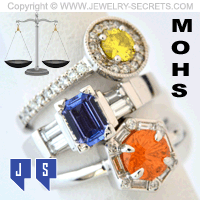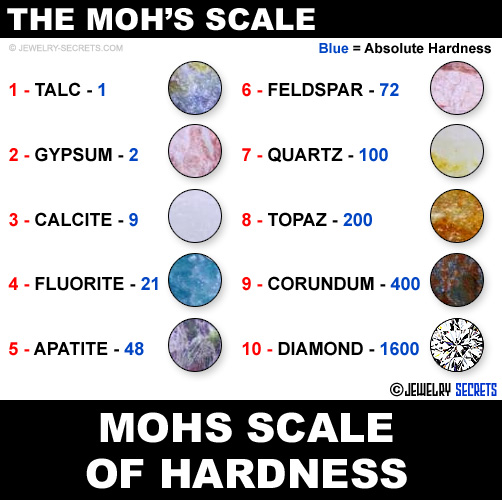WHAT DOES THE MOH’S SCALE OF HARDNESS MEAN TO JEWELRY?
WHY THE MOH'S SCALE OF HARDNESS MATTERS WITH GEMSTONES & JEWELRY!
This post contains affiliate links. If you use these links to buy something I may earn a commission. Thanks! As an Amazon Associate I also earn from qualifying purchases.

The MOH’s scale of hardness is a scale used to measure the hardness of minerals and gemstones. It was created by Friedrich Mohs in 1812, and it is still widely used today.
The scale ranges from 1 to 10, with 1 being the softest and 10 being the hardest.
At the bottom of the scale is talc, which is a very soft mineral that can be easily scratched. At the top of the scale is diamond, which is the hardest mineral and can only be scratched by another diamond. Other common minerals and gemstones fall somewhere in between on the scale.
The Mohs Scale of Hardness is as follows:
- TALC – 1
- GYPSUM – 2
- CALCITE – 9
- FLUORITE – 21
- APATITE – 48
- FELDSPAR – 72
- QUARTZ – 100
- TOPAZ – 200
- CORUNDUM – 400
- DIAMOND – 1600 (Numbers after Name are Absolute Hardness)

The MOH’s scale of hardness is important to jewelry because it helps determine how durable a gemstone is and how well it will hold up over time. Gemstones that are high on the scale, such as sapphire and ruby, are more resistant to scratches and are therefore better suited for everyday wear. Gemstones that are low on the scale, such as opal and pearl, are more delicate and need to be handled with care to avoid scratches and damage.
So to go deeper into all of the gemstones, and their hardness, let’s look at the extended Moh’s Scale and see where everything falls:
Extended Mohs Scale:
|
|
When selecting jewelry, it is important to consider the hardness of the gemstones used. For example, if you are looking for an engagement ring that will be worn every day, you may want to choose a diamond or a sapphire, both of which are high on the MOH’s scale of hardness. If you are looking for a piece of jewelry that will be worn occasionally, you could easily choose a gemstone that is lower on the scale, such as an opal or a pearl.
But more most people, and most jewelry for everyday wear, it’s wise to stay at least 7 or higher on the scale.
It is also important to note that the MOH’s scale of hardness is not the only factor to consider when selecting gemstones for jewelry. Other factors, such as color, clarity, and rarity, should also be taken into account. Additionally, some gemstones may be treated or enhanced to improve their durability or appearance, so it is important to work with a reputable jeweler who can provide information on the quality and authenticity of the gemstones used in their jewelry.
So you see, the MOH’s scale of hardness is an important tool for understanding the durability and wearability of gemstones used in jewelry.
By considering the hardness of a gemstone, along with other factors such as color and clarity, you can make an informed decision when selecting jewelry that will not only look beautiful but also stand the test of time.
Cheers! :)


















Leave a comment